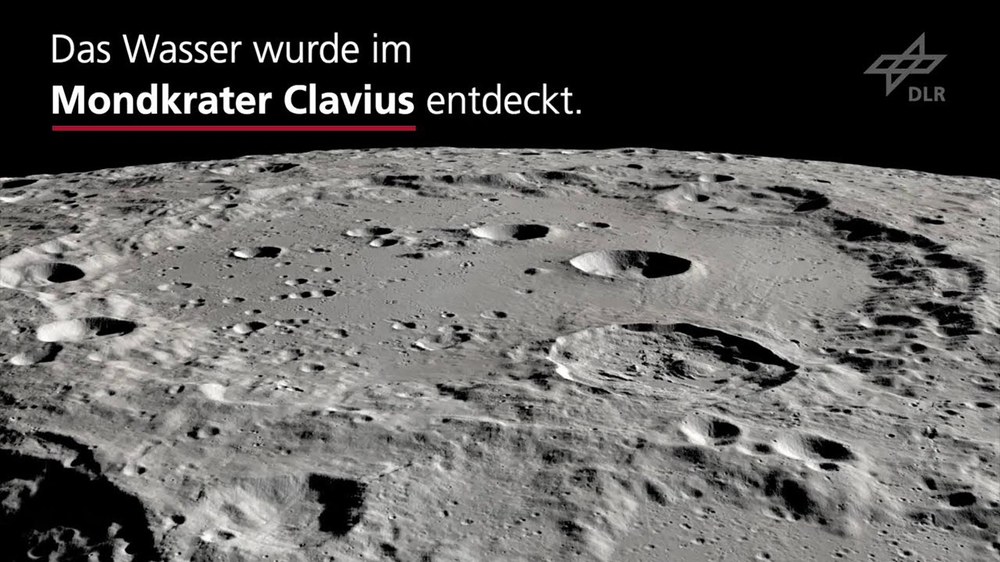The flying observatory SOFIA discovers water molecules on the Moon

- The SOFIA flying observatory makes the first detection of water molecules outside the permanent shadow at the Moon's poles.
- The molecules were detected with the FORCAST instrument in the vicinity of Clavius Crater in the Moon’s southern hemisphere.
- The results of the research were published in the scientific journal Nature Astronomy on 26 October 2020.
- Focus: Space
The Stratospheric Observatory for Infrared Astronomy (SOFIA) has provided the first direct and unambiguous evidence of water molecules on the Moon outside the permanent shadow at the lunar poles. The infrared observatory, which is operated by US space agency NASA and the German Aerospace Center (Deutsches Zentrum für Luft- und Raumfahrt; DLR) was able to detect the molecules in the Moon’s southern hemisphere using SOFIA’s FORCAST instrument (Faint Object InfraRed CAmera for the SOFIA Telescope). The findings from the scientific research were published on 26 October, 2020 in the journal Nature Astronomy.
“We have been looking for water on the Moon since the first lunar rocks were brought to Earth in the 1960s,” says Alessandra Roy, SOFIA project scientist at the DLR Space Administration. “However, most of these samples showed no evidence of its presence.” The scientists only obtained confirmation of its existence in 2008, from NASA's Moon Mineralogy Mapper on board the Indian Chandrayaan-1 mission, and this demonstrated the presence of water only in the Moon’s dark polar regions. SOFIA has now been able to demonstrate that water also exists in areas of the Moon’s surface that are illuminated by the Sun. The airborne infrared observatory had already used the FORCAST instrument to observe the Moon on 30 August 2018. This allowed scientists to identify the unmistakable fingerprint of water molecules in the mid-infrared range (at a wavelength of six micrometres) in the vicinity of the Clavius Crater in the Moon’s southern hemisphere.
Where does the Moon's water come from?
"The sunlit parts of the Moon can reach temperatures of approximately 120 degrees Celsius. Having practically no atmosphere, there is no protection for its water which at this temperature evaporates under the heat of the light from the Sun. There is no way of catching any of it," says Roy. "However, water is present on the surface." Currently, there are two theories to explain the presence of water on the surface. Some scientists believe that micrometeorites falling onto the Moon's surface and carrying small quantities of water could deposit the liquid within the rock as they collide with it. In the process, the water becomes enclosed in tiny, glass, bead-like structures in the ground. However, there is also the possibility that a two-stage process may occur, in which hydrogen from the solar wind reaches the Moon's surface, where it combines with hydroxyl – a hydrogen atom bound to an oxygen atom – to form water. The data acquired by SOFIA indicates that most of the water that has been detected lies within the substrate covering the lunar surface.
Water as the basis for future space missions
One of the objectives of the ESA Space Resources Strategy, which focuses on the Moon, is to confirm whether resources such as water could enable sustainable space exploration. "The amount of water discovered by SOFIA is roughly equivalent to the contents of a 300-millilitre can of drink, spread over the same surface area as a football pitch," explains Roy. "The Moon remains drier than deserts on Earth, but the quantity of water that has been discovered could still prove important for future crewed missions in space."
SOFIA will now observe the Moon's sunlit surface during different lunar phases to investigate the water phenomenon in greater detail. The scientists hope that this will open up new insight into where water on the Moon comes from, how it is stored, and how it is distributed across the lunar surface. Data from SOFIA will complement the findings from future Moon missions.

SOFIA discovers water on the Moon
Your consent to the storage of data ('cookies') is required for the playback of this video on Youtube.com. You can view and change your current data storage settings at any time under privacy.
NASA/USRA
About SOFIA
The Stratospheric Observatory For Infrared Astronomy (SOFIA), is a joint project of the German Aerospace Center (Deutsches Zentrum für Luft- und Raumfahrt; DLR) and the National Aeronautics and Space Administration (NASA). The German contribution to the project is managed by the DLR Space Administration, using funds provided by the Federal Ministry for Economic Affairs and Energy (Bundesministerium für Wirtschaft und Energie, BMWi), the State of Baden-Württemberg and the University of Stuttgart. German scientific operations are coordinated by the German SOFIA Institute (Deutsche SOFIA Institut; DSI) at the University of Stuttgart; US activities are coordinated by the Universities Space Research Association (USRA). Development of the German instruments is funded by the Max Planck Society (Max-Planck-Gesellschaft; MPG), the German Research Foundation (Deutsche Forschungsgemeinschaft DFG) and DLR.

